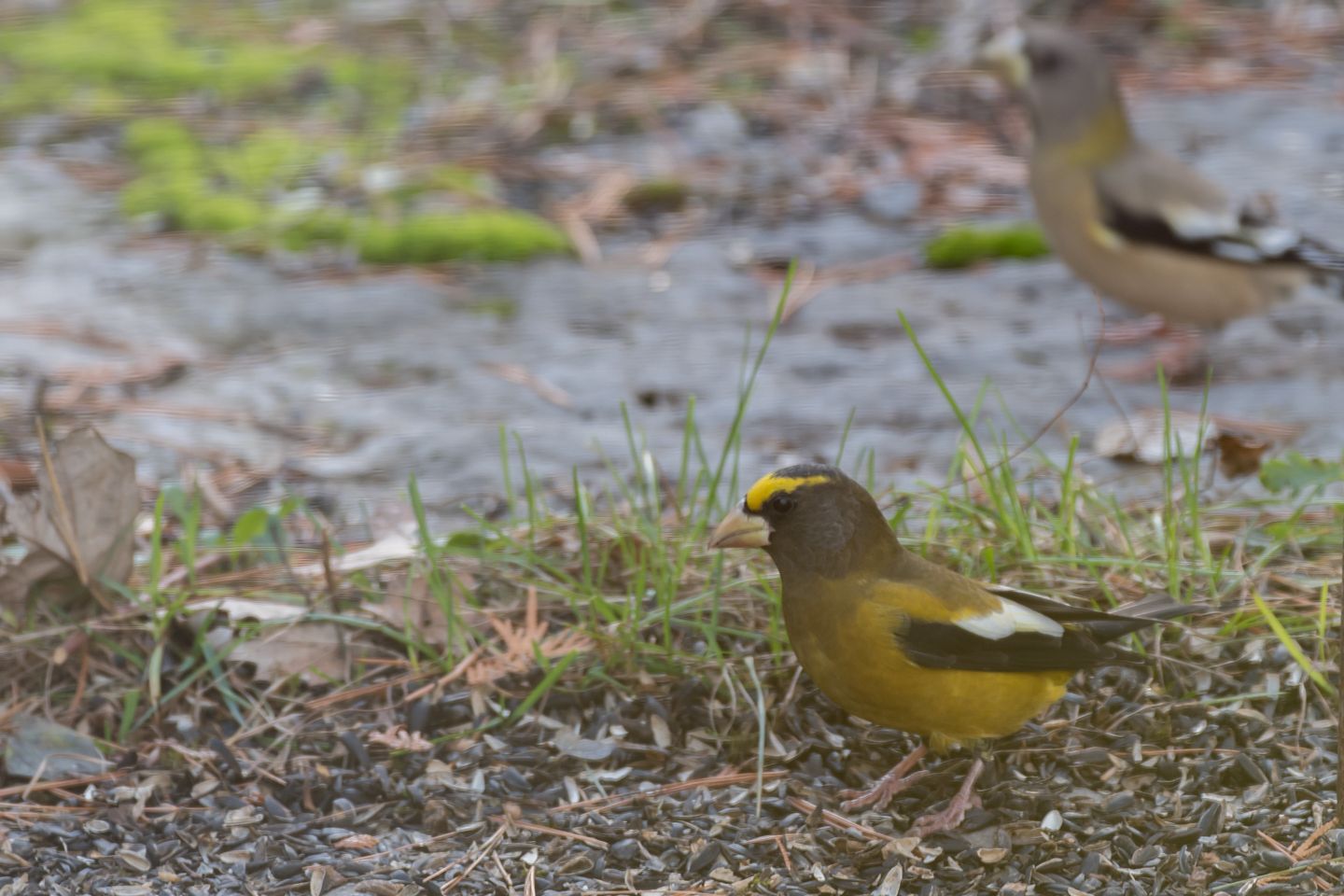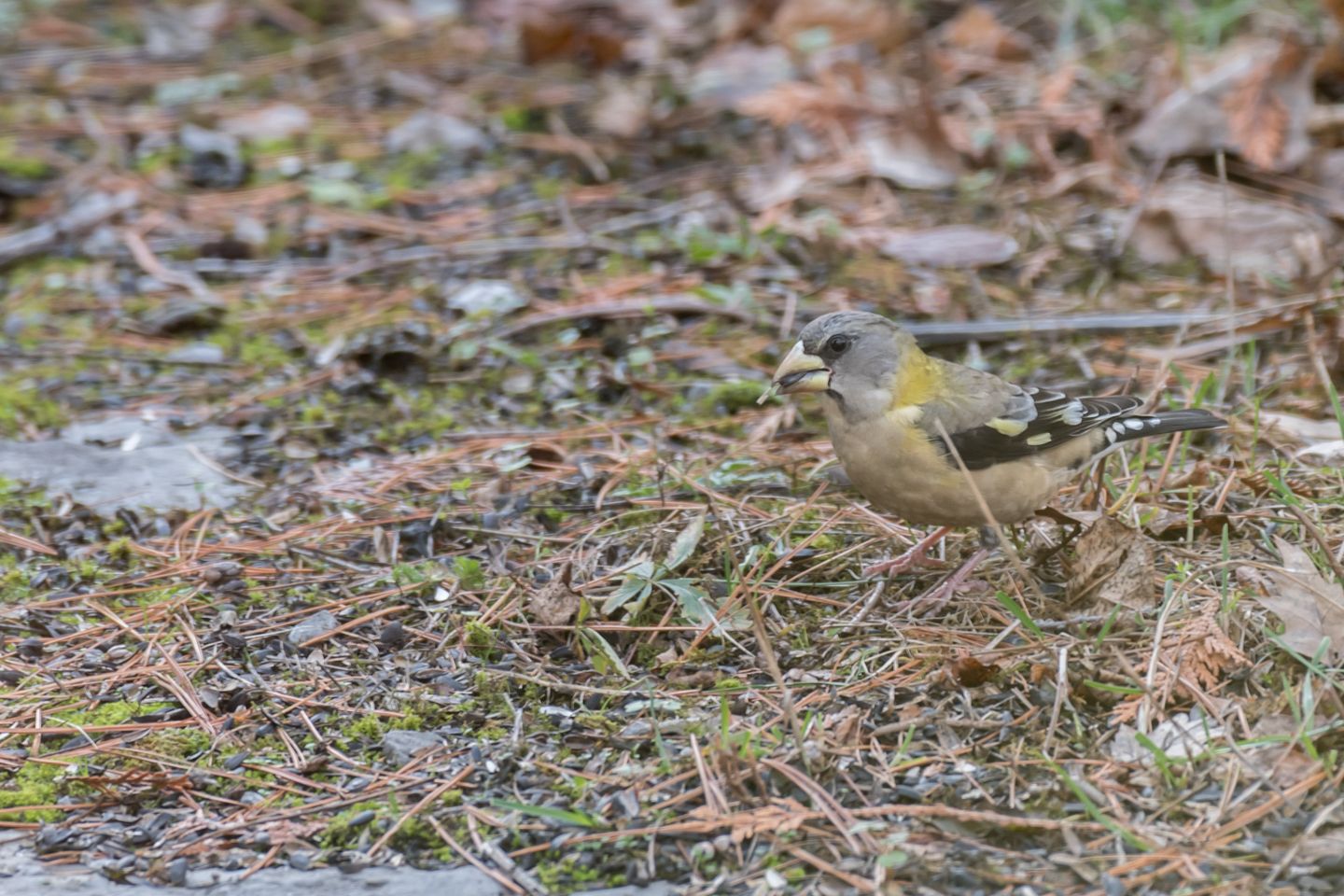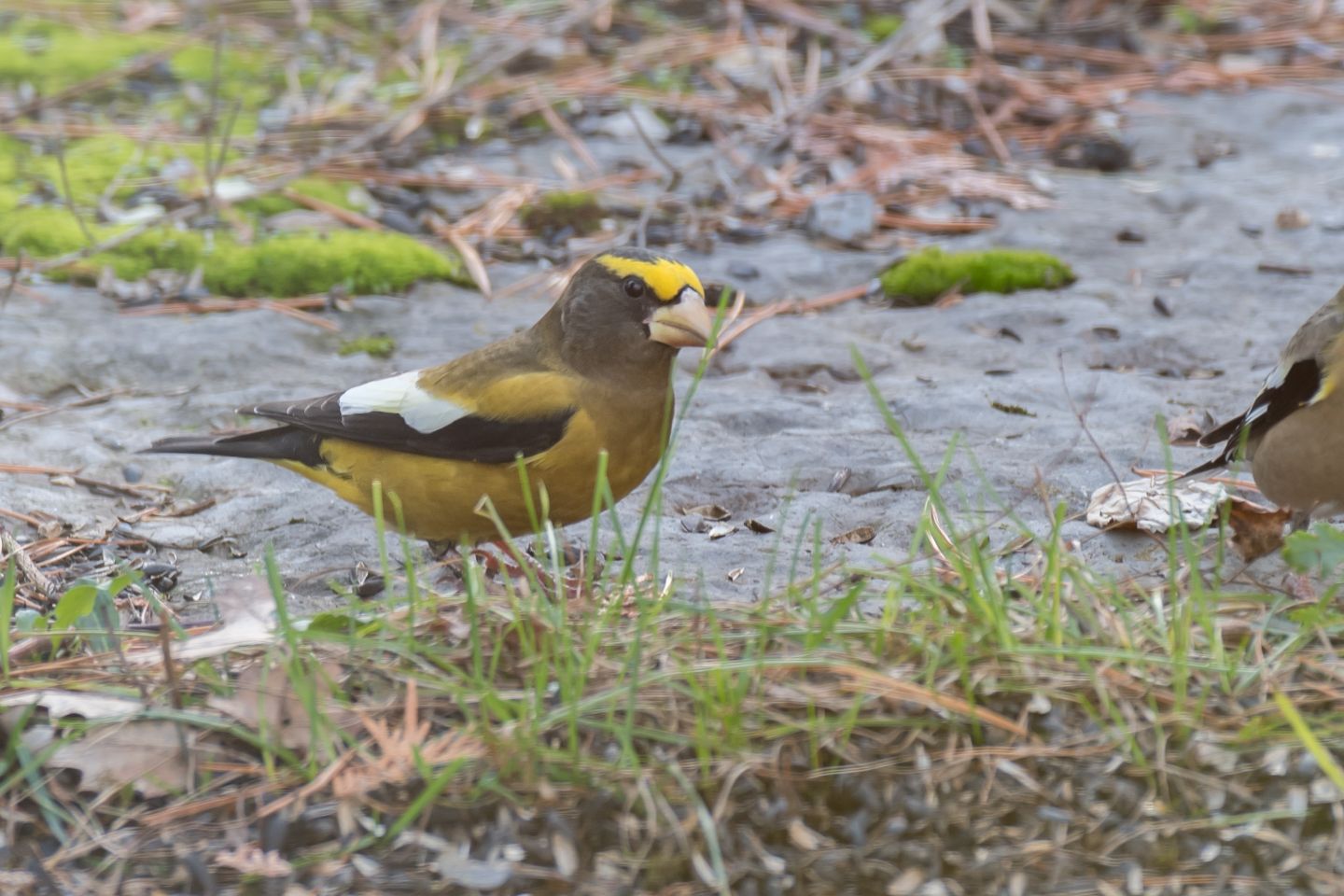As noted last month the Common Redpoll continues to be the most obvious species in this winter’s northern finch invasion. As a denizen of open country their flocks are easily detected as they wheel through weedy fields and along roadsides. Other species occupy primarily wooded and brushy habitats. While the Evening Grosbeak takes advantage of well stocked bird feeders, Red Crossbill, White-winged Crossbill and Pine Grosbeak rarely partake of such largesse. These species must usually be sought out in the hinterlands where trees bearing cones or wild fruits can be found.

The large, handsome, Evening Grosbeak was a common winter bird in our region when I began birding more than a half century ago. Flocks large and small were regularly found at bird feeders throughout New York State and southern Ontario. Many a bird feeding station owner bemoaned the sunflower seed bills when a flock of “Grospigs” settled on their feeder for many weeks. Historically Evening Grosbeaks were virtually absent from Northeastern North America prior to the 1920s. Suddenly, after being known primarily in regions northwest of Lake Superior, they became increasingly regular in the east. That situation remained until the mid-1990s when they once again became scarce.
During the past quarter century, Evening Grosbeaks have been absent from much of the region in most years. Only in the last half decade have we had notable incursions, even if these paled by comparison to those of the last half of the twentieth century. While we don’t know why they were previously rare or common, we do know why the major recent declines occurred. It seems this sunflower seed vacuum cleaner of November to May, has a very different appetite in the summer. Then, they are connoisseurs of spruce budworm caterpillars which occur in their boreal forest breeding range. Budworms cause periodic infestation in parts of the extensive northern forest. When they do, many species of migrant birds, particularly wood warblers, have high reproductive success and populations explode.

Now it seems the Evening Grosbeak populations that visit us also undergo similar cycles during periods of infestations. And why the large declines over the last 25 years? Much of the Boreal Forest is owned by resource harvesting corporations whose profits may be impacted by spruce budworm infestations. Thus, attempts have been increasing to control these natural cycle outbreaks. It's a bad idea fighting Mother Nature, we as usual, have little idea of potential side effects. Attempts at controlling budworms also impact their natural predators, most likely resulting in a zero sum game while probably causing problems we have no idea are occurring.
Probably my absolute favorite winter finch is the rarest one in our region, even during invasion years. The Pine Grosbeak, with the spectacular pink, adult males, seems to have longer duration between invasions than its congeners. Only about once in a decade does this species venture into our region in significant numbers. Even when they do, most flocks are small and comprised of greenish immature birds and females. The brilliantly colored adult males are usually a distinct minority in the flocks one sees. Most groups, in my experience, are comprised of less than 25 individuals. In past decades I have seen flocks of 150-200, but my impression is that such groups are hard to come by even during major incursions. The observer witnessing such a group, that may be 10-25 percent adult males, sees a moving mass of pink feathers on bushes or gravel roadsides.
While the occasional Pine Grosbeak may visit a feeder the best place to search for them is anywhere fruit bearing vegetation can be found. They are preferential frugivores in winter, devouring remaining fruits from ornamental plantings, native shrubs, or invasives such as buckthorn and honeysuckle. If these birds are present in any area they are easy to locate and see, since they frequently utter a sweet melodic call and are extremely tame. Easily approached and seemingly unaware of modern menaces such as automobiles, this species and many other winter finches are vulnerable to being road killed when they come south into more human dominated areas. Pine Grosbeak is often the last winter finch to arrive in invasion years. Keep looking as they appear to be moving toward us from farther northeast
Perhaps the two species of crossbills, Red and White-winged, are the most enigmatic of the group we call winter finches. Unlike other species, their invasions aren’t really properly called such. While most flights come from northerly directions, these birds are true nomads moving erratically in search of areas containing large crops of cones of conifer trees. These birds have evolved specialized beaks that are ideal tools for extraction of seeds from their casings. True birds of conifer forests, they rarely occur far from cone bearing trees. To see crossbills, one must visit areas where trees are laden with cones and look for flocks, while listening for their distinctive and abundant calling.
The nomadic crossbills do their other finch relatives one better, during flight years when they find areas with abundant cone crops. While most birds are primarily concerned with just survival through the winter, crossbills, may be thinking of other things. In early February in good Red Crossbill years, observers may be treated to the full breeding song as territory is being defended in the depths winter. Soon thereafter, eggs are laid in a nest in a snow-covered spruce. The young arrive basically naked, as most songbirds are at hatching. To our eyes this would seem apparent madness, but hey - it works for them! With good parenting and a rich diet of conifer seeds and a few other tidbits and soon the family is flocking with other broods to look for more cones.

Recently, the taxonomy of North American birds placed the finches, which we have discussed in the last two articles in TI Life, as among the most evolutionary advanced of our birds. The constant reassessment being done by academics and their graduate students using DNA considerations, has resulted in great flux in the world of avian taxonomy. While these activities, with the frequent species name changes that accompany them, are a constant vexation to those of us communicating with the public, the birds couldn’t care less. They just go about their business of day-to-day survival to continue their species on this planet. In the short term, this extraordinary group we call winter finches seems to be doing ok at the game of survival. Their Boreal Forest habitat largely intact, they grace us with their presence at irregular, but somewhat predictable intervals. The best thing for us to do is get outside and enjoy their presence, while remembering their future like all living creatures on Earth is in our hands.
Good Finching!
By Sherri Leigh Smith
Sherri Leigh Smith is the Senior Ornithologist in northern NY. He is passionate about birds and their conservation. Sherri Leigh has written numerous articles for TI Life, and you can see several of them here.
Posted in: Volume 16, Issue 1, January 2021, Nature
Please click here if you are unable to post your comment.
